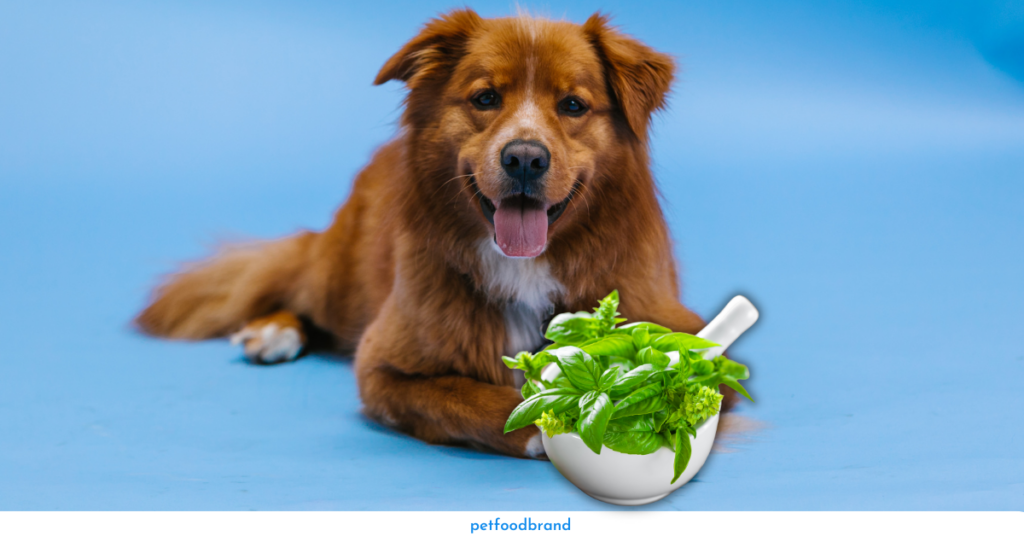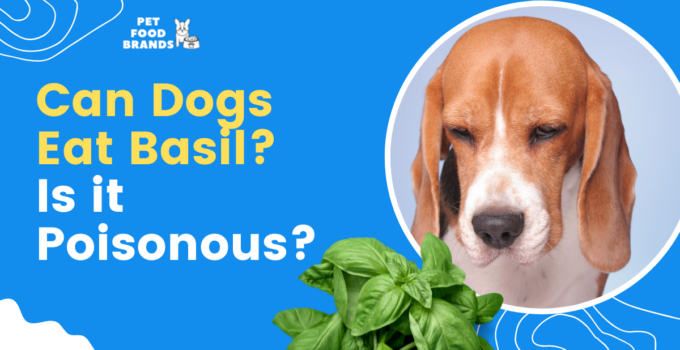Basil is a herb native to the Mediterranean, as well as many other parts of the world. It is also known as sweet basil and has a distinctive lemony flavor. It is a small green plant with leaves that have a strong, licorice-like aroma. Its leaves and flowers are used in cooking and making tea, which can help reduce stress or relieve anxiety.
Can dogs eat basil?

Yes, dogs can eat basil! Not only is it healthy for your dog to eat in small quantities, but basil also helps prevent many kinds of illness including cancer and cellular damage. It has high levels of antioxidants that contribute to its anti-inflammatory effects as well.
Health Benefits of Basil For Dogs
Basil contains Calcium, Vitamin A, Vitamin K, Vitamin B, Beta carotene, Beta cryptoxanthin, Iron, minerals, and a wide range of antioxidants.
- Helps to calm the nerves
- Promotes healthy skin and hair
- Suppresses bad breath
- Promotes good digestion
- Provides relief from respiratory issues
- Relieves allergies
The Calming Effects of Basil on Dogs
The calming effects of basil on dogs are due to the presence of the chemical Ocimene. It has been shown to help dogs with anxiety, stress, and fear. When compared to other herbs, basil was more effective.
How much basil can I give my dog?
While your dog needs a lot of nutrients, they should not be given too much basil. If the amount is too high, it can cause serious health problems.
One teaspoon of basil is enough for a small dog; two teaspoons will be fine for a medium-sized dog; while three teaspoons are appropriate for a large or giant-sized dog. One tablespoon can also be used as long as the amount is kept within reason.
Are basil plants toxic to dogs?
Basil plants are generally not toxic to dogs, but if your dog ingested the plant in large quantity, you should contact your vet.
Basil plants may be toxic to dogs because of the oils that they contain, which would cause them stomach aches and vomiting if ingested on a large scale.
Is Genovese basil safe for dogs?
Genovese basil i is normally safe for dogs, though there are some who have reported that they have had issues with their dogs eating the leaves and getting digestive issues like stomach aches,
Frequently Asked Questions
How do I serve Basil to dog?
Basil is very versatile when it comes to serving it to dogs. You can easily sprinkle it on their food, or you can even mix some into a treat for them if they prefer that. It is also a common ingredient in many recipes and dishes as well so there are plenty of ways your dog can enjoy this herb.
Can Dogs Eat Raw Basil?
Most dogs can handle a bit of basil. You’ll want to make sure the basil is fresh, not overly ripe or rotten so it doesn’t have a bad flavor. Though some dogs will appear to reject it, which is expected with any type of new food.
Can dogs eat basil leaves?
Basil leaves can be toxic to dogs when eaten in large quantities. There are different ways to make sure that your dog doesn’t get poisoned by the leaves. Normally, dogs can eat basil leaves safely.
Can dogs eat basil pesto?
Yes, dogs can eat basil pesto. However, the amount that they should eat is very small and should be done sparingly. It contains a lot of oil, so if your dog is allergic to nuts or seeds, they may be allergic to basil pesto.
Can dogs eat basil seeds?
Basil seeds are typically given to dogs as a treat. However, some people believe that basil seeds can be toxic to dogs and should not be fed regularly.
Basil seeds can be toxic for dogs if fed in large quantities. They contain calcium oxalate crystals, which can cause irritation in the mouth and stomach, resulting in vomiting and diarrhea.
Can dogs eat basil flowers and stems?
Basil flowers and leaves are considered to be non-toxic to dogs under normal circumstances. It’s important that you only feed them in moderation if you want to avoid any issues with their digestive system.
Here is a story of Bailey reported by a Reddit user.
Bailey is a 4-year old golden retriever who loves basil leaves. Basil has been one of her favorite things ever since she was a puppy, but recently her owner started noticing that she needed to go outside more often to relieve herself because her urine was turning yellow. She had become lethargic and wasn’t able to play like she used to before all of these changes happened. When Bailey’s owner took her to the vet, they found out that Bailey had consumed approximately 500 leaves of basil which was enough for her body weight. Luckily, Bailey survived this incident and has recovered from the ordeal now!

Ankita is a passionate pet lover and head of content at Pet Food Brands. With her extensive knowledge and research, she provides pet owners with top-quality information on dog food and nutrition. Her dedication to improving the lives of dogs makes her a leading voice in the industry.




